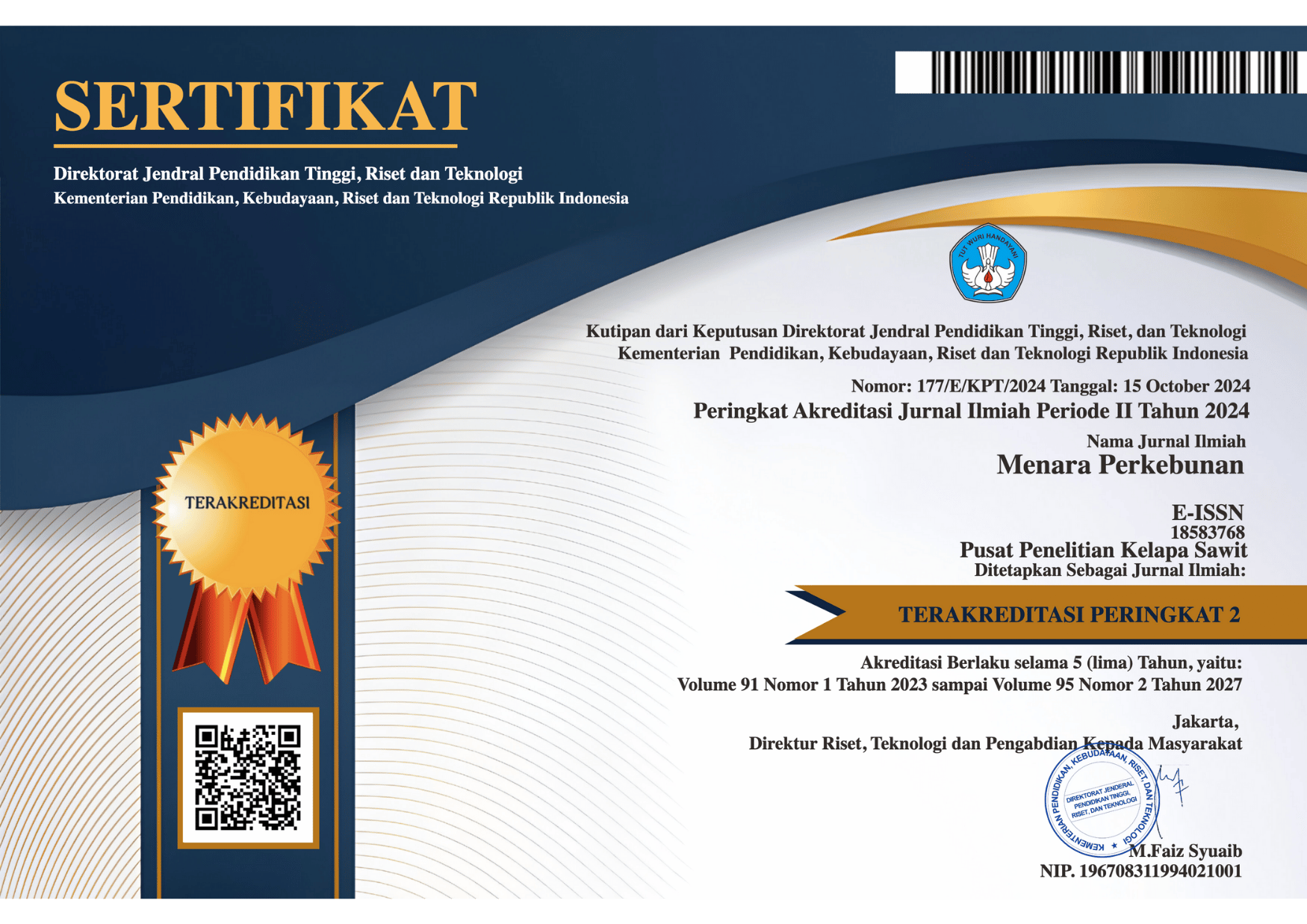Optimasi sterilisasi permukaan eksplan stek mikro tanaman karet Optimization of surface sterilization on rubber microcutting explan
DOI:
https://doi.org/10.22302/iribb.jur.mp.v81i1.55Keywords:
Hevea brasiliensis, in vitro, rootstock micropropagation, clonal propagationAbstract
Abstract
An increasing number of explants is necessary to
obtain plantlets in large quantities, for mass propagation
of rubber plants. However, high level of contamination at
the primary culture stage is still a major constraint in in
vitro microcutting of rubber. The aim of this study was to
optimize surface sterilization procedures to reduce micro-
bial contamination at the primary culture. Sterilization
experiment was conducted in two step., The first step was
to determine the effect of washing the explants with
running water prior to sterilization and then using Deso-
germe, ethanol or H 2 O 2 , while the second step was to
identify the suitable sterilization process on reducing the
level of contamination. The results showed that the surface
sterilization with only one type of sterilization agent could
not reduce contamination level caused either by bacteria
or fungi, while sterilization with three types of sterilizing
agents increased the number of dead explants. The best
treatment for surface sterilization was the direct
sterilization of explants using 70% ethanol for one minute
and 17.6% H 2 O 2 for 20 minutes without washing with tap
water (A-CD treatment). The percentage of viable and
aseptic explantsof this treatment was 76.7%, which was
significantly higher than those of other treatments. This
treatment reduced contamination level to 21.7%.
Abstrak
Peningkatan jumlah eksplan sangat diperlukan untuk
memperoleh planlet dalam jumlah besar pada perbanyakan
massal tanaman karet secara in vitro. Namun, tingginya
tingkat kontaminasi pada tahap kultur primer masih me-
rupakan kendala utama dalam kultur stek mikro tanaman
karet. Tujuan penelitian adalah mengoptimasi prosedur
sterilisasi permukaan eksplan untuk mengurangi jumlah
eksplan yang terkontaminasi mikroba pada tahap kultur
primer. Percobaan sterilisasi dilaksanakan dalam dua
tahap, tahap pertama untuk mengetahui pengaruh pen-
cucian eksplan dengan air mengalir pada awal sterilisasi
serta penggunaan Desogerme, etanol dan H 2 O 2 , sedang-
kan tahap kedua untuk mendapatkan proses sterilisasi yang
paling sesuai dalam menurunkan tingkat kontaminasi.
Hasil penelitian menunjukkan bahwa perlakuan sterilisasi
permukaan yang menggunakan satu jenis bahan sterilan
tidak dapat mengurangi kontaminasi, baik oleh bakteri
maupun cendawan. Perlakuan sterilisasi eksplan dengan
tiga jenis bahan sterilan meningkatkan kematian eksplan.
Perlakuan sterilisasi permukaan terbaik adalah sterilisasi
langsung eksplan menggunakan etanol 70% selama satu
menit dan H 2 O 2 17,6% selama 20 menit, tanpa pencucian
dengan air mengalir (perlakuan A-CD). Persentase eksplan
steril yang hidup sebesar 76,7%, berbeda nyata dibanding-
kan dengan perlakuan lainnya. Perlakuan tersebut dapat
mengurangi kontaminasi menjadi sebesar 21,7%.
Downloads
Downloads
Submitted
Accepted
Published
How to Cite
Issue
Section
License
Copyright (c) 2016 Jurnal Menara Perkebunan

This work is licensed under a Creative Commons Attribution 4.0 International License.
Authors retain copyright and grant the journal right of first publication with the work simultaneously licensed under a Creative Commons Attribution License that allows others to share the work with an acknowledgement of the work's authorship and initial publication in this journal.













